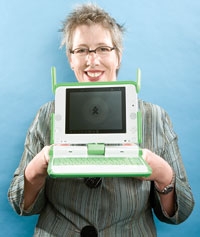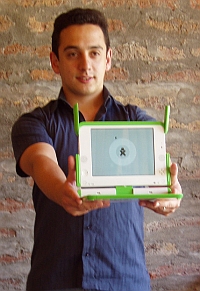Omatek Smartbook: Local 4P Computing Innovation
Earlier this month, I had the luxury of inspecting a new Omatek Smartbook at the Ministry of Education in Ghana. The Smartbook is a low-cost laptop aimed at the education market, and with one look, you’l know its an XO laptop derivative:
It also happens to be one of the many
4P Computers that are coming out of the developing world. Not content to leave the 4PC market to Asus, these local computer manufactures are making their own low-cost, highly-portable, power-efficient, and performance-relative computers for local and regional markets.
From OLPC to ASUS: An Overview of 4P Computing
Three years ago, the IT industry was shocked with a radical idea – a “$100 laptop” designed specifically for education in the developing world. Price would be low and yet quality high, through innovative design mixed with low-cost components, and sales would be focused exclusively on the developing world.
This heretical bombast upset the longstanding computer manufacturing tradition to keep adding functions to maintain high prices in the developed world, while ignoring the developing world. While the revolution was lead by One Laptop Per Child and its visionary founder, Nicholas Negroponte, we now have a whole plethora of revolutionaries – from the upstart Asus to the goliath Intel – who are developing 4P Computers.
4P Computing is a new class of appropriate technology – computing power, performance, portability, and price specificity designed for the realities and markets of the developing world.
Now join Wayan Vota, an expert on ICT in the developing world, in an overview of this revolution, the resulting 4PC’s, and their impact on the whole information and communication technology industry:
Asus Eee PC is the 4P Computing Market Leader
With the plethora of new 4PC’s (computer power, performance, price, and portability perfectly suited for the developing world), coming out of Computex this year, you might be wondering who is the current market leader. Personally, I would have to say its Asus with its popular Eee PC line.
Now that may surprise those that know me as a One Laptop Per Child fanboy, but as I told the Economist in its article “The rise of the low-cost laptop“:
By raising the very possibility of a $100 laptop, the XO presented the industry with a challenge. Wayan Vota, founder of OLPCNews.com, an independent website that follows the project, calls the XO a “harbinger of an entirely new class of computers”.
As such a harbinger, OLPC took the concept of 4P Computing, first conceptualized by the Simputer, and made it a practical reality with the XO laptop. But in the many missteps we chronicled on OLPC News, it never really commercialized its lead.
The Comming Computex 4P Computing Competition
Now that One Laptop Per Child has brought the 4P Computing vision into reality, and Asus proved its market with the Eee PC, expect to see an amazing plethora of form factors at this year’s Computex that ascribe to the power, performance, price, and portability required by the developing world.
But don’t take my learned opinion on the matter, just listen to Mary Lou Jepsen, inventor of the XO laptop’s dual mode screen:
So many new machines are coming out about the size of the XO laptop. I’ve heard that 50 distinct different laptop models will be introduced at Computex (in Taiwan) alone in early June. These machines use screens between 7-10″ diagonals – and have been slapped together rather quickly to capitalize on the momentum first created by One Laptop per Child.
Now she sees the new 4PC entrants being high on price, and they are. The cheapest 4PC laptops that I’ve seen are still around $450 for the base models.
The Rise of 4P Computing Solutions for the Developing World
Last August, I crowded a few friends into a Japanese restaurant in Silicon Valley to talk about technology in the developing world. Back then, the discussion swirled around One Laptop Per Child, as it was the most visible manifestation of our collective drive to spread appropriate information and communication technology beyond the world’s elite.
That’s because three years ago, Nicholas Negroponte stunned the technology industry and the development community with an amazing idea: One Laptop Per Child – a rugged yet low-cost computing device, the XO laptop, can empower primary education in the developing world.
His idea that low-power, appropriate performance, highly portable, and low-priced computers were not only possible, but could also radically change education in the developing world and computer manufacturing in the developed world was an instant hit with Presidents of the Global South.
While the global telecommunications industry was quick to dismiss his idea as folly, as I told the Economist in its article “The rise of the low-cost laptop“, they did not laugh long:


